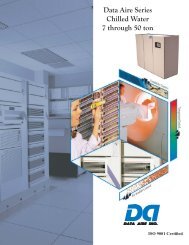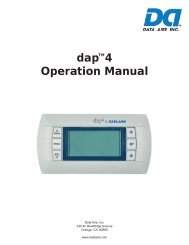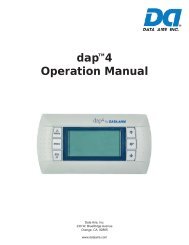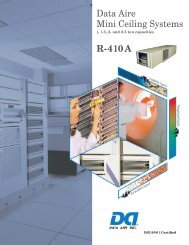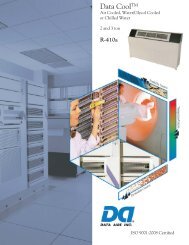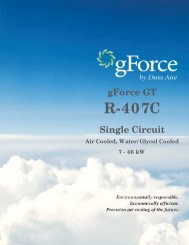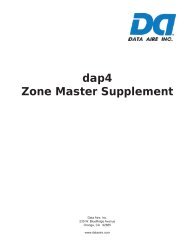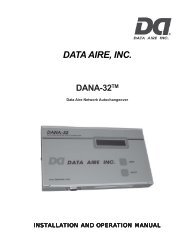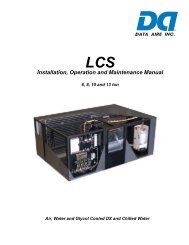Installation, Operation and Maintenance Manual - Data Aire
Installation, Operation and Maintenance Manual - Data Aire
Installation, Operation and Maintenance Manual - Data Aire
You also want an ePaper? Increase the reach of your titles
YUMPU automatically turns print PDFs into web optimized ePapers that Google loves.
NOTE: Charging to a full liquid line sight-glass should never be the sole means of determining<br />
the correct refrigerant charge. Other parameters such as superheat, suction<br />
pressure, head pressure, sub-cooling <strong>and</strong> ambient temperature are also important. A<br />
system charged to a clear sight-glass is often overcharged.<br />
5.2.4 Flooded System Charging<br />
Flooded systems include an optional liquid receiver <strong>and</strong> head pressure control valve for use primarily<br />
in colder climates. When the ambient temperature falls during cold weather, the head pressure<br />
control valve will regulate the fl ow of refrigerant to ensure nearly constant receiver pressure.<br />
The receiver is partially fl ooded with liquid refrigerant in cold weather. In warm weather the extra<br />
refrigerant is stored in the receiver.<br />
Flooded systems require more refrigerant than units with fan speed control. Connect the pressure<br />
gauge manifold set to the high <strong>and</strong> low ports near the compressor. Connect the charging line to<br />
the refrigerant tank <strong>and</strong> set it for liquid feed. Open the refrigerant tank valve <strong>and</strong> purge the line at<br />
the manifold. Open the high side valve on the manifold only <strong>and</strong> allow the refrigerant to fl ow until<br />
the system pressure equalizes. At this point the system will have 75 to 85% of the total refrigerant<br />
charge. Start the evaporator blower. Start the compressor <strong>and</strong> check the operating pressures<br />
<strong>and</strong> temperatures.<br />
For units with either the Mini DAP-III or DAP-III, a quick <strong>and</strong> easy way to run the blower <strong>and</strong> compressor<br />
is by using the manual switches provided with the microprocessor (located in the control<br />
module). Switch the blower <strong>and</strong> compressor manual switches to the ON position. All automatic<br />
control is disabled but safety switches will remain functional.<br />
WARNING: Before starting a compressor, the crankcase heater should be energized<br />
for a minimum of 12 hours to reduce the possibility of liquid slugging on start-up. Failure<br />
to energize the crankcase heater could result in compressor damage. If the system<br />
is charged from a vacuum, the pre-heating of the compressor is not necessary.<br />
Start the evaporator fan <strong>and</strong> verify the fan rotation. Start the compressor. Check the liquid line<br />
sight-glass to get a feel for the approximate charge. Bubbles in the sight-glass are not unusual at<br />
this point <strong>and</strong> can be caused by fl ashing from liquid pressure drop, low sub-cooling or low charge.<br />
It is likely more refrigerant will be required to complete the charging procedure.<br />
If the receiver (head) pressure is below 230 PSIG, block part of the condenser coil surface until<br />
the pressures rises to 230 PSIG or greater. During extremely cold weather all the condenser fans<br />
may have to be de-energized to maintain 230 PSIG.<br />
Observe the sight-glass on the receiver. Add refrigerant through the suction line until the level of<br />
liquid in the receiver is approximately 1/3 from the bottom of the sight-glass (the leveling ball in the<br />
receiver will start to fl oat). At this point the charging is correct. Observing the receiver sight-glass<br />
becomes diffi cult when they are remotely mounted near the condenser. The unit should be allowed<br />
to stabilize for several minutes before meaningful measurements can be taken.<br />
After the system is allowed to stabilize, the superheat at the compressor suction line (reading from<br />
at least 6 inches from the compressor) should be 8 to 15°F. Units with remote condensing units<br />
25



